An Autumn Migration Tour today. The gusty north wind of the last couple of days had dropped and the cloud of the morning even gave way to some sunny intervals in the afternoon. We met at Cley and started the day out on the reserve.
Lots of ducks and geese have been arriving for the winter over the last few days. As we walked out to the hides, a large flock of Wigeon flew in from the direction of the sea. They circled over the reserve several times, looking for a place to land, possibly fresh in from their Russian breeding grounds. A few dropped down, but most of the flock flew on west. We could see a Marsh Harrier flying across low over the reeds but when we positioned ourselves to get a better view of it, it dropped down out of view.
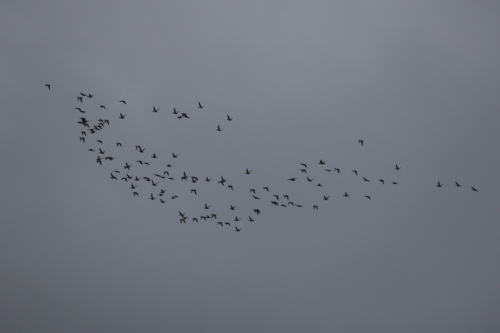 Wigeon – this flock was probably just arriving from Russia
Wigeon – this flock was probably just arriving from Russia
Teal Hide was our first stop. Appropriately enough, as we opened the shutters, a single (Eurasian) Teal was in the ditch right in front of the hide. With two visitors from Canada in the group today, we discussed the various differences between the species found in North America and Europe and how the changing definition of what makes a ‘species’ had resulted in the separation of the Old World and New World forms of some birds in recent years.
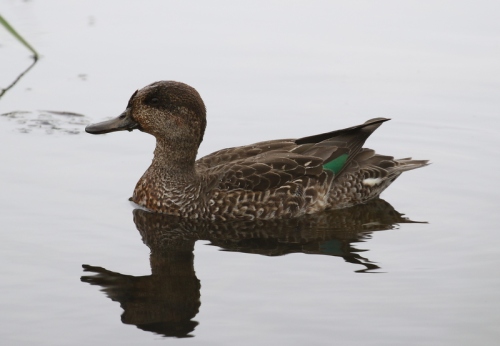 (Eurasian) Teal – in the ditch in front of Teal Hide this morning
(Eurasian) Teal – in the ditch in front of Teal Hide this morning
With wildfowl arriving from the continent now, it was perhaps no surprise that Pat’s Pool was full of ducks. Unfortunately, they are not looking their best at the moment, with the drakes mostly in eclipse plumage. A Shoveler was swimming around in front of the hide with its head in the water, shovelling. There are plenty of Wigeon in on the reserve already now and lots of Teal as well.
There were a few waders too. We had a look at the flocks of Black-tailed Godwits. Most were asleep, perched on one leg, but a few further back were awake and feeding. Almost all of the Ruff are now in winter plumage – grey-brown above and off white below – but one was confusingly still in partial summer plumage, with lots of black feathering on its belly. A group of six small Dunlin worked their way round to the front of the scrape – digging their bills into the mud rapidly, like a sewing machine. A few Golden Plover dropped in onto one of the islands. A single Common Snipe was hiding in the wet grass, but helpfully came out into the open where we could get a good look at it.
The waders seemed very skittish today, and kept flying round at the slightest provocation. Lots of raptors learn that this is a good place to find a meal, which keeps the other birds on their toes. Looking out across the reedbed, a Peregrine flew inland from the beach over the back of the reeds, and started circling over Walsey Hills, at which point it was promptly mobbed by several of the local Rooks.
The three Greenshank we had seen from Teal Hide had flown off by the time we made our way round to Dauke’s Hide. But still, there was an impressive number of waders on Simmond’s Scrape. There were at least 100 Dunlin on here today, mostly juveniles with black speckled bellies. Around the edges, we also found nine diminutive Little Stints, an impressive number of this rarer passage wader, as well as seven Ringed Plover and two Knot. There was a lone Curlew out on Simmond’s today too. At one point, when the smaller waders were all spooked and flew round, they landed around the Curlew and we were presented with Little Stint next to Curlew – the largest of our regular waders together with our smallest, little and large!!
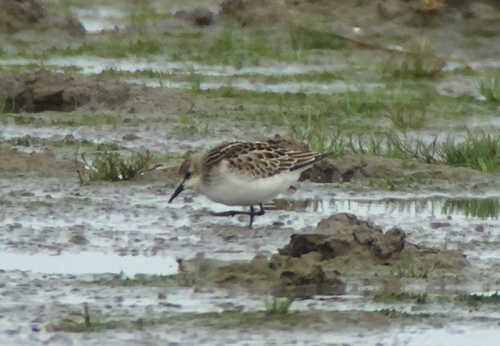 Little Stint – an impressive 9 were on Simmond’s Scrape
Little Stint – an impressive 9 were on Simmond’s Scrape
On the short grass around the edge of the scrape, a couple of Wheatears were feeding, the first of several we would see today. At one point, they flew up and landed on the gatepost out from the hide where we could get a good look at them. Then a Sparrowhawk flew in, flushing everything, and landed on one of the islands. It did push a Green Sandpiper out of hiding, which flew over and seemed to drop down on Whitwell Scrape. However, when we got round there, there was no sign of it. Three Little Egrets were feeding out on Cricket Marsh beyond though.
We decided to make our way back to the visitor centre for coffee. As we walked back, a flock of six Pink-footed Geese flew over, also probably freshly arrived for the coming winter, in their case from their breeding grounds in Iceland. They didn’t stop, but carried on west.
After a short break, we drove along to the Iron Road. The muddy pools here have been good at times in recent weeks, but there were no waders at all on there today. Looking out towards the shingle ridge and the sea, we could see a small group of six Brent Goose flying in. A flock of four Pintail flew overhead, probably also fresh in. They looked to land on Watling Water but seemed nervous and kept whirling round again rather than dropping down to the water.
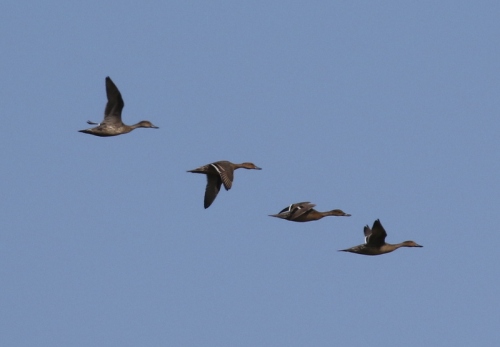 Pintail – these four were probably more fresh arrivals
Pintail – these four were probably more fresh arrivals
The walk round to Babcock Hide produced another Wheatear, this one much closer, hopping around on the short grassy field in front of us, showing off its sandy orange breast in the sunshine. Further over, we could see several Egyptian Geese in with the Greylags and Canada Geese which all gather her.
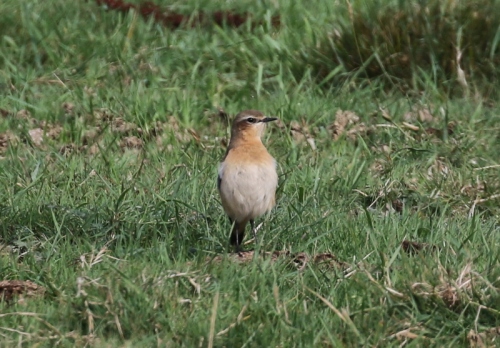 Wheatear – feeding on the grazing marshes on the way to Babcock Hide
Wheatear – feeding on the grazing marshes on the way to Babcock Hide
The water level of Watling Water has increased again after the recent rain, so there were fewer waders on here than recently. A Green Sandpiper was sleeping on one of the islands, back on and flashing its mostly white rear end. We got a smart juvenile Ruff in the scope. Three Curlews dropped in for a bathe and preen.
However, we were more fascinated by the antics of the Mute Swans. A couple of immature birds, with dull orange bills, had landed out on the shallow water. The local pair decided to see them off and the male (cob) set off after one of them, with wings raised. The intruder simply walked away, eventually climbing up onto the bank, before making a cheeky circle round and straight back onto the water.
More exciting, we could see two Hobbys between the hide and the shingle ridge, hawking for dragonflies low over the reeds. A couple of Little Grebes were diving out in the deeper water. Then it was time to head back to the visitor centre at Cley, where we stopped for lunch.
After lunch, we decided to see if we could see the Red-breasted Flycatcher which has spent the last couple of days just along the coast from here. Breeding in northern and eastern Europe, it is a very scarce visitor to the UK. We parked at Salthouse duck pond and walked along to Meadow Lane. A Reed Bunting flicked up from the path into the bushes beside us. We could see a female Marsh Harrier circling ahead of us, which then flew in our direction, chased by a couple of Rooks.
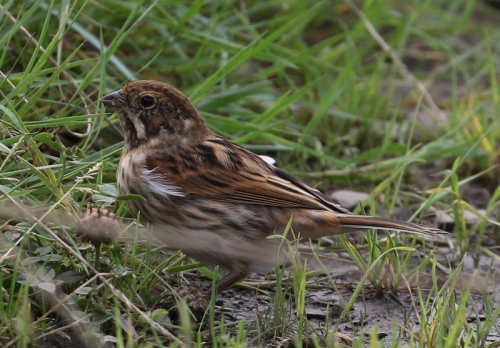 Reed Bunting – feeding along the path at Salthouse
Reed Bunting – feeding along the path at Salthouse
The Red-breasted Flycatcher had by all accounts been elusive before we got there, but we had a very good but brief view of it flicking around on the near edge of the sallows only a minute after we arrived. We stood and waited for more, and it quickly became clear that it was doing a small circuit through the trees.
While we watched, it was amazing how many other birds came out of such a tiny clump of low trees. Two Willow Warblers, with lemon yellow breasts, two lumbering rusty brown Reed Warblers and even a tiny little Goldcrest.The latter was undoubtedly a migrant and we had earlier been talking about how the smallest British bird, weighing no more than a 20p piece, can make its way over the North Sea to winter here. Amazing!
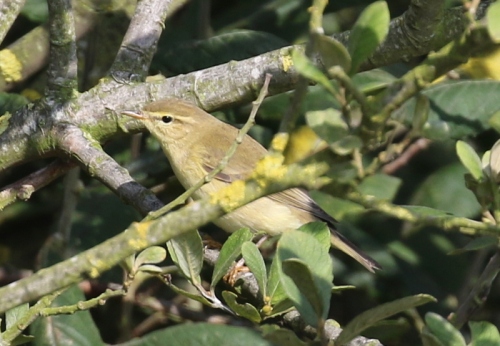 Willow Warbler – two of these appeared in the sallows
Willow Warbler – two of these appeared in the sallows
The Red-breasted Flycatcher appeared again at our end of the sallows a couple of times, but did not really show itself – either hiding in amongst the leaves or just flicking out for a second before darting back into the middle of the bushes. We were thinking we might have to content ourselves with our earlier views, when it finally came out to the front and perched in full view for about a minute. It was a first winter Red-breasted Flycatcher, without the red breast which is shown only by the adult male, but a smart bird nonetheless. When it turned and flicked away again, we got a good look at its black tail with white sides.
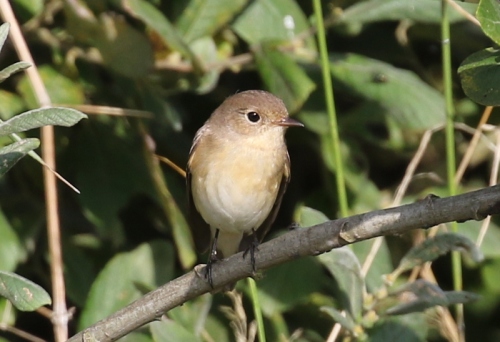 Red-breasted Flycatcher – perched out nicely for us
Red-breasted Flycatcher – perched out nicely for us
As we walked back to the car, two more Mute Swans flew towards us and passed just over our heads. Huge birds and we could almost feel the beating of their wings.
Our final destination of the day was Stiffkey Fen. The path out to the fen is rather overgrown at the moment and it is hard to see over the hedges. Early afternoon, the bushes and trees were a little quiet. A male Kestrel perched up on the wires and pylons by the path. We made our way straight out to the seawall, so we could get a good look at the Fen.
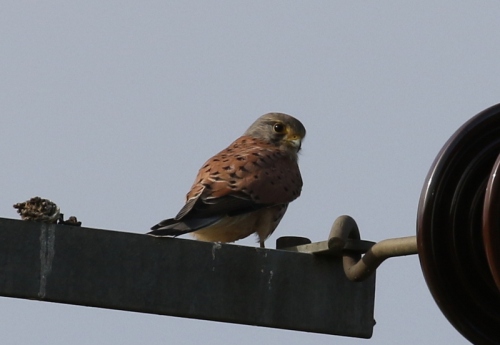 Kestrel – on the wires and pylons by the path at Stiffkey Fen
Kestrel – on the wires and pylons by the path at Stiffkey Fen
We had hoped to see some Spoonbills at Stiffkey Fen, but there was no immediate sign of any as we got up onto the seawall. There was a nice selection of ducks, including a good number of Wigeon and several Pintail. In with the large gaggle of Greylags. we could see a couple of white ‘farmyard’ geese and the regular two escapee Bar-headed Geese.
There were plenty of waders too. Several large groups of Black-tailed Godwit were scattered around the Fen. Many were roosting in the shallow water, on one leg with head turned and bill tucked in, but a few were awake enough to give us a good view of their long, straight bills. In with them, we could see several Ruff, including one with a striking white head – even in winter plumage, they are still a very variable wader, a very common source of confusion.
We could hear Greenshank calling and saw one flying in from the direction of the harbour. A large group of Common Redshank were roosting in with the godwits, and several more were feeding out in the channel on the harbour side. We could see all the Seals out on the sand banks beyond the end of Blakeney Point. When we turned back to the Fen, a Spoonbill was just flying off NE, towards the saltmarsh – it must have been hiding out of view behind the reeds. As it came past us, we could see its spoon-shaped bill.
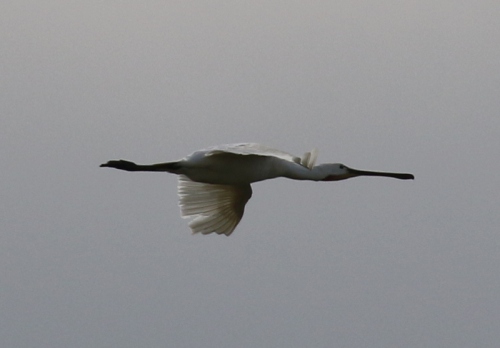 Spoonbill – flew off towards the saltmarsh
Spoonbill – flew off towards the saltmarsh
We noticed a commotion at the far side of the Fen and turned to see all the waders take off and whirl round. A sleek, streamlined shape scythed through them – a Hobby. It had its eyes fixed firmly on a Dunlin which was desperately flying away ahead of it. When the Dunlin jinked and turned, the Hobby matched it – amazingly manoeuvrable. Somehow, the Dunlin managed to get away and the Hobby towered up and away towards the harbour.
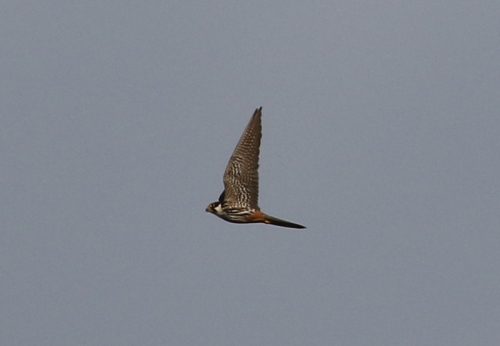 Hobby – chased a Dunlin from the Fen
Hobby – chased a Dunlin from the Fen
The tide was still out, but we made our way round to look in the harbour. Two Oystercatchers were feeding on the mud by the channel, the first we had seen today. We flushed a Wheatear from beside the path, which flew off ahead of us, flashing its white rear. It landed on the path briefly, then flew up onto a post nearby, giving us great views. A little further on, a Linnet perched up on a dead branch in the Suaeda bushes.
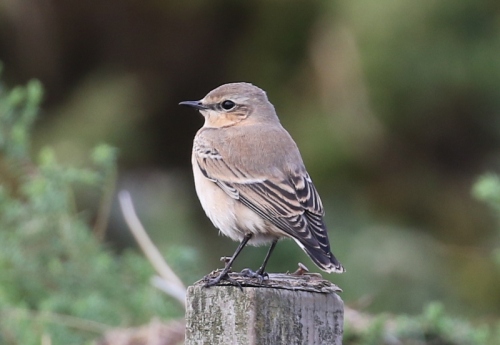 Wheatear – feeding on the path on the way out to the harbour
Wheatear – feeding on the path on the way out to the harbour
There were lots of gulls roosting out in the harbour, on the dry mud banks, and with them we could see several larger white shapes. Through the scope, we confirmed that they were more Spoonbills. We watched two of them preening – doing themselves first, before preening each other’s head and neck. Two more Spoonbills were feeding in the water just below them.
There were lots more Oystercatchers out in the harbour, but with the tide still out it was hard to see many waders. We did manage to find a single Bar-tailed Godwit, out with the Curlew and Shelduck, and a nice Turnstone feeding on the mud down amongst the boats, turning stones over to look for food underneath. A Grey Heron flew in high over the harbour calling. There are often Grey Herons around here, but the way this one flew in made us think it might be a migrant. There have been lots of migrant Grey Herons arriving here in the last few days.
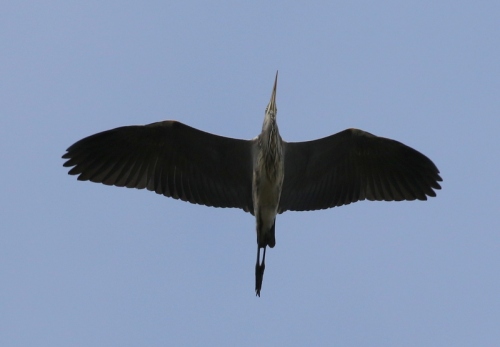 Grey Heron – possibly a freshly arrived migrant
Grey Heron – possibly a freshly arrived migrant
However, the highlight of our time down by the harbour was the Kingfisher. It was perched on the wires on the edge of the deck of one of the boats moored in the channel. Periodically it would dart down into the shallow water after fish, flashing electric blue as it did so, before flying back up to a different part of the boat. It also perched on the edge of the deck and on the anchor chain. At one point, it seemed to take offense at its own reflection in the window of the boat, and flew at it, but it quickly realised the error of its ways and went back to looking the other way, over the side and down into the water below.
It was a lovely way to finish a very productive day’s birding on the coast – watching the Kingfisher going about its business in the harbour. We made our way back and headed for home.

Thanks for an excellent day on the marshes. Your description and photographs are a great record of where we went and what we saw.
Hi Dave & Susan – glad you enjoyed the day, and the write up of it too. Best regards, Marcus